An applicant for a hydroelectric license must use the Integrated Licensing Process (ILP) to prepare a license application unless the Commission approves the applicant’s request to use the Traditional or Alternative Licensing Process.
This webpage is intended to guide participants through the ILP. It is not a substitute for understanding and following the regulations (Part 5). Additional suggestions about how to implement a successful ILP can be found in Ideas for Implementing and Participating in the Integrated Licensing Process (ILP): Tools for Industry, Agencies, Tribes, Non-Governmental Organizations, Citizens, and FERC Staff.
Preparing an Application
Process
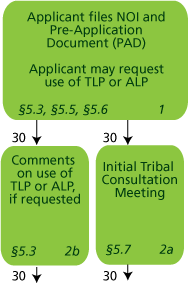
An applicant must provide certain information to stakeholders and the Commission so these entities can understand the proposed project, identify any environmental issues, identify any information needs or studies, and provide meaningful comments and recommendations on the proposed project.
Notice of Intent
Notification of intent (NOI) is an unequivocal statement of the potential applicant's intention to file an original license application, or, in the case of an existing licensee, to file or not to file an application for a new or subsequent license.
- A potential applicant for an original license or relicense must file a notification of its intent (NOI) to file a license application and a Pre-Application Document (PAD).
- Applicants seeking a relicense must file the NOI and PAD between five and five and one half years before the expiration of the existing license.
An applicant can also file a request to use one of the Commission's other licensing processes, the Traditional Licensing Process or the Alternative Licensing Process. For additional information about these processes see our Licensing Processes Section.
- For an NOI template, see: NOI Template
- For a request to use the TLP template see: TLP Request template
Pre-Application Document (PAD)
The PAD is a document that describes the proposal and existing, relevant information about the project's effects on resources. An applicant is not required to conduct studies to generate information for the PAD; rather an applicant is expected to exercise due diligence to gather existing information. This includes contacting stakeholders for information relevant to the project, the environment, and potential project effects.
It is important that the PAD contains:
- A clear description of the project;
- A concise description of the existing environment and resource impacts to the extent they are known;
- A list of issues and information or studies proposed to fill identified information gaps;
- A list of relevant comprehensive plans;
- A process plan that sets the schedule for developing the license application; and
- A summary of contacts made to seek out information to develop the PAD.
Additional Information
Information in the PAD should be a concise summary of the relevant data, focusing on information relevant to the issues uncovered during the development of the PAD. The process plan and schedule should coordinate the Commission's information needs with any other agency processes (e.g., Coastal Zone Management Act, Clean Water Act, and Endangered Species Act consultation). Such coordination is best accomplished through early dialog with the agencies while preparing the PAD. Applicants are encouraged to include a protocol in the PAD that describes how it will distribute information. Applicants may use electronic means or compact disks to distribute information but must provide the information in hard copy upon request.
- For a PAD template, see: PAD Template
- PAD Adequacy Review Checklist
Tribal Consultation
To ensure that the Commission is aware of tribal concerns and that an affected tribe understands how to participate in the licensing process to share those concerns, Commission staff will attempt to hold a meeting with potentially-affected tribes within 30 days of the filing of the NOI and PAD.
For more information on the Commission's policy for consulting with Native American tribes, see Tribal Policy Statement.
Process
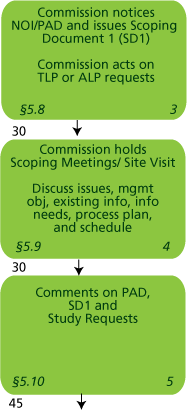
Scoping is a process for identifying and determining the extent of issues to be addressed in the Commission's environmental assessment (EA) or environmental impact statement (EIS) (40 CFR §1501.7) for the project.
Within 60 days after the Notice of Intent (NOI) and Pre-application Document (PAD) is filed, Commission staff will issue a public notice of scoping meeting(s) in a newspaper serving the counties in which the proposed project is located. The notice will provide the location and time of the meeting(s). At the same time, Commission staff will also issue a scoping document (SD1) that describes the issues that will be addressed in its EA or EIS. Comments are due within 60 days of the issuance date of the notice.
Commission Conducts Scoping and Site Visit
Scoping meetings are intended to be interactive. The applicant typically provides an overview of its proposed project, which is followed by a discussion of the issues as outlined in the Commission's SD1 and any possible information gaps. Commission staff, with the assistance of the applicant, typically conducts an environmental site review (site visit) in conjunction with agency and public scoping meetings. However, depending on the project location and season, the site visit can be scheduled separately.
Within 45 days of the close of the comment period, Commission staff will revise and issue the scoping document (SD2), as needed, based on the comments provided at the scoping meetings and any written comments filed in response to the scoping notice.
Study Requests
See 18 CFR § 5.9(b)
As part of scoping, agencies, tribes, non-governmental organizations, the public, (stakeholders) and Commission staff may request the applicant to conduct studies and gather information to address issues and fill identified information gaps. Study requests are due 60 days from the issuance of the scoping notice.
To ensure that the requested studies are fully supported, each study request must:
- Describe the goals and objectives of each study proposal and the information to be obtained;
- If applicable, explain the relevant resource management goals of the agencies or Indian tribes with jurisdiction over the resource to be studied;
- If the requester is not a resource agency, explain any relevant public interest considerations in regard to the proposed study;
- Describe existing information concerning the subject of the study proposal, and the need for additional information;
- Explain any nexus between project operations and effects (direct, indirect, and/or cumulative) on the resource to be studied, and how the study results would inform the development of license requirements;
- Explain how any proposed study methodology (including and preferred data collection and analysis techniques, or objectively quantified information, and a schedule including appropriate filed season(s) and the duration) is consistent with generally accepted practice in the scientific community or, as appropriate, considers relevant tribal values and knowledge; and
- Describe considerations of the level of effort and cost, as applicable, and why proposed alternative studies would not be sufficient to meet the stated information needs.
For additional guidance on how to develop study requests, see: A Guide to Understanding and Applying the Integrated Licensing Process Study Criteria.
Process

Before the Commission can make an informed decision on a license application, it must obtain adequate information on all aspects of the project, including effects on fish and wildlife, cultural, recreational, and tribal resources. To obtain this information, if it does not already exist, the applicant typically conducts studies. The following outlines the steps leading to a Commission-approved study plan.
Proposed Study Plan and Resolving Study Disagreements
Once the comment period on the Pre-Application Document closes, the applicant has 45 days to prepare and file a proposed study plan. The study plan must address each of the study criteria and explain how the proposed studies address the issues raised during scoping and fill the information gaps identified by the stakeholders.
Over the next 90 days, the applicant, stakeholders, and Commission staff work to resolve disagreements over study needs. The regulations require that at least one meeting occurs within 30 days of filing the proposed study plan. The applicant leads the meeting. Stakeholders should come prepared to discuss and clarify their information needs.
By the close of the 90-day comment period, stakeholders may file comments on the applicant's proposed study plan and submit revised study requests. Comments should reflect any remaining concerns with the study plan and any agreements reached with the applicant to address their concerns.
Revised Study Plan
- From the close of the 90-day comment period on the proposed study plan, the applicant has 30 days to file a revised study plan for Commission approval.
- The plan must address the study criteria and explain any agreements or continued disagreements overstudies.
- Stakeholders have 15 days to file comments on the revised study plan.
OEP Director's Study Determination
- Within 30 days of the filing of the revised study plan, the director of the Office of Energy Projects will issue a study determination approving the study plan with any modifications based on the record.
- The applicant must conduct the studies required by the Commission-approved study plan. Nothing prevents applicants and agencies from agreeing on studies in addition to those approved in the study plan determinations.
See 18 CFR 5.14
Process

Any Federal land managing agency with authority to provide mandatory conditions for a license pursuant to section 4(e) of the Federal Power Act (e.g., U.S. Forest Service), or to prescribe fishways pursuant to section 18 of the Federal Power Act (U.S. Department of Interior or Commerce), or any agency or tribe with authority to issue a water quality certification under section 401 of the Clean Water Act can request that any study rejected by the Director that is related to its mandatory conditioning authority be re-examined by an independent panel.
The panel is composed of three members that have no previous connection to the licensing process for the project:
- One from the disputing agency;
- One from the Commission; and
- One resource expert is chosen by the two other panel members from a list of experts maintained by the Commission.
The Director will consider the recommendations of the panel, and issue a written determination considering the study criteria and any applicable law or Commission policy and practices. The determination will explain why any panel recommendation was rejected, if applicable. The determination shall constitute an amendment to the approved study plan. The applicant is required to conduct the approved studies as amended.
For the list of resource experts, see Third Panel Members' List For Study Dispute Resolution By Resource Expertise.
To apply to be placed on the list, follow the directions in Notice Requesting Applications for Panel Member List for Hydropower Licensing Study Dispute Resolution.
For a history of requested study disputes and outcomes, see Requests for Study Dispute Resolution.
See 18 CFR § 5.15
Process

- To ensure that studies are gathering the needed information, applicants must periodically report on the progress of implementing the approved study plan and the data being gathered.
- The first report is due within one year of the Director's study determination.
- If multiple years of study are required, subsequent reports are due each year thereafter,
- The study report(s) should include a description of the overall progress implementing the approved study plan; any variances from the approved study plan; and proposed modifications to the approved study plan (if any).
- The applicant must hold a meeting with stakeholders within 15 days of filing the report to discuss study results and any proposals to modify the study plan.

See 18 CFR § 5.16
Process
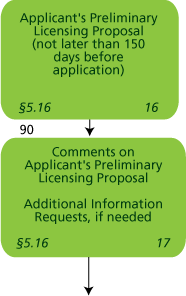
Applicants must file a preliminary license proposal (PLP) that describes the project proposal, existing and proposed project operation, existing and proposed environmental measures and the effects of the project proposal on environmental resources. Applicants for a new or subsequent license must file the PLP at least 150 days prior to the deadline for filing the license application.
Protection, Mitigation and Enhancement Measures, Settlements and Draft License Application
The PLP should also include a description of proposed measures and plans to protect, mitigate, or enhance environmental resources (e.g. a Draft Biological Assessment, Essential Fish Habitat Assessment, Historic Properties Management Plan, Recreation Management Plan, etc). Filing drafts of the plans and measures with the PLP will facilitate the filing of final plans and measures with the license application, which is strongly encouraged by the Commission, see: Guidance on Environmental Measures in License Applications.
It is during this period that applicants and stakeholders often enter into settlement discussions to resolve issues related to licensing the project. The Commission looks with great favor on settlements in licensing cases. For information on the Commission's policy on settlements, see Policy Statement on Hydropower Licensing Settlements.
Applicants may elect to file a draft license application, which would include all remaining elements of the application (for example, Exhibits A, F, G, and H). Filing a draft license application may help expedite Commission processing of the final license application by identifying application deficiencies early.
Comments on the PLP or DLA are due within 90 days of its filing. Any requests for additional studies based on the PLP must include a demonstration of extraordinary circumstances pursuant to 18 CFR 5.15(f).
Processing the License Application
Process

The applicant should include time in its schedule for reviewing and addressing any comments received on the preliminary licensing proposal or draft license application before filing the license application. If the license application is for a new or subsequent license, the applicant must file the license application at least two years before the existing license expires.
Filing the License Application
The applicant must serve on every resource agency, affected tribe, and other consulted stakeholders copies of:
- The application;
- Any written correspondence from the Commission asking the applicant to correct a deficiency or provide additional information; and
- Any deficiency corrections, revisions, supplement, response to additional information requests, or amendments to the application.
The applicant must certify that copies of the final application have been mailed to these agencies and stakeholders. For original license applications, the applicant must provide a copy of the final application to landowners adjacent to the proposed project. The applicant must also file the final application with the Commission's Secretary and a copy to the appropriate Division of Dam Safety and Inspection | Regional Office Hydropower Contacts.
Applications may be filed electronically via the Internet. See 18 CFR 385.2001(a)(1)(iii) and the instructions on the Commission's website under the eFiling link. For assistance, please contact FERC Online Support: [email protected]; call toll-free at (866) 208-3676; or, for TTY, contact (202) 502-8659. Although the Commission strongly encourages eFiling of documents, documents may also be paper-filed. To paper-file, mail an original and 7 copies to:
Kimberly D. Bose, Secretary
Federal Energy Regulatory Commission
888 First Street, NE
Washington, DC 20426
Applicants must provide public notice of the filing of the application no later than the filing date of the application in a daily or weekly newspaper in each county in which the project would be located. For a public notice template, see Application Filing Public Notice Template.
Application Contents
The application must contain all information required in 18 CFR § 5.18, including maps and drawings that permit Commission staff to determine: a) the location of the project and the extent of land area affected by the project, and b) the proposed design of all power-producing structures and equipment. See the ILP Application Checklist.
For instructions on how to file exhibit drawings, see: Preparing Exhibit Drawings for a License or Exemption Application.
Commission Noticing of the Application and Ready for Environmental Analysis
Within 14 days of the filing, the Commission will issue a notice of the filing of the application that will contain a preliminary schedule for expeditious processing of the application.
Within 30 days of filing the application, Commission staff will notify the applicant if the application does not conform to the Commission's regulations. An application that does not conform to the regulations is considered deficient. The applicant has up to 90 days from the date of the deficiency notification to correct the application or the Commission will reject it.
Within 30 days of filing the application, the Director of the Office of Energy Projects will also issue a determination resolving any outstanding requests for additional information gathering or studies made in comments on the preliminary licensing proposal or draft license application.
If the application is complete, and staff does not require any additional information to process the application, Commission staff will publish notice that the application is accepted and ready for environmental analysis (REA). Interventions, comments, recommendations, and terms and conditions are due within 60 days of the notice. Reply comments on any filings are due with 45 days of the close of the comment period.
Within 60 days from the issuance of the REA notice, the applicant must provide the Commission with a copy of the Section 401 Water Quality Certification, a copy of the request for Section 401 Water Quality Certification, or evidence of waiver of the water quality certification [see 18 CFR § 5.23(b)].
Process
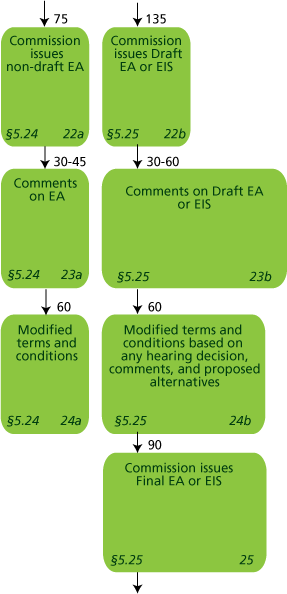
The National Environmental Policy Act, or NEPA, requires federal agencies to assess the effect of its actions on the environment. The Commission typically does this through an environmental assessment (EA). If the Commission staff determines that there would be a significant effect on the quality of the human environment, Commission staff must prepare an environmental impact statement (EIS).
- If the Commission determines that the environmental issues pertaining to the project are likely to be relatively minor, then it will prepare a non-draft (final) EA no later than 75 days after the close of the comment and reply comment period set forth by the notices of acceptance and ready for environmental analysis (REA).
- If the Commission determines that the environmental issues pertaining to the project are more complex, it will prepare a draft EA or EIS no later than 135 days after the notices of acceptance and REA.
The notice issuing the EA or EIS will specify when comments on the EA/EIS are due. The comment period varies between 30 and 60 days and depends on the complexity of the issues and analysis.
- Federal resource agencies may file modified terms and conditions. Modified terms and conditions are due 60 days after the close of the EA, draft EA, or draft EIS comment period.
- If the Commission issues a draft EA or EIS, it will issue a final EA or EIS within 90 days of the close of the period for filing modified terms and conditions.
Process
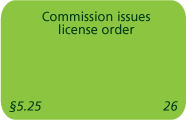
The Commission will issue its decision on the license application once it has everything it needs to complete processing (for example, the water quality certification issued pursuant to section 401 of the Clean Water Act, a Biological Opinion, documentation of consistency with the Coastal Zone Management Act). The decision will be based on staff recommendations described in the EA or EIS and any mandatory conditions issued pursuant to sections 4(e) and 18 of the Federal Power Act (FPA), section 401 of the Clean Water Act, and other relevant law.
Section 10 of the Federal Power Act (FPA)
All licenses shall be issued on the recommendations specified in section 10 of the FPA and such other conditions as the Commission determines are lawful and in the public interest [18 CFR § 5.29(h)]. Under Section 10(a) of the FPA, the Commission must ensure that the project to be license is best adapted to a comprehensive plan for developing the waterway for beneficial public purposes. The Commission must include conditions based on recommendations by federal and state fish and wildlife agencies submitted pursuant to section 10(j) of the FPA to "adequately and equitably protect, mitigate damages to, and enhance fish and wildlife (including related spawning grounds and habitat)" affected by the project unless such conditions are inconsistent with the FPA or other applicable law.
License Term
Original licenses are issued for a term up to 50 years; new or subsequent licenses are issued for terms between 30 and 50 years. A new license (relicense) is issued for an existing hydroelectric project that is subject to sections 14 and 15 of the Federal Power Act. A subsequent license is issued for a project with an expiring minor or minor part license, not subject to Sections 14 and 15 of the FPA. License terms are based on the amount of redevelopment, new construction, new capacity, or environmental mitigation, and other factors such as coordination of license terms for multiple projects in a river basin.
Rehearing
Any party (applicant or entity with intervenor status) may file a request for rehearing of the license within 30 days from the date of its issuance.
